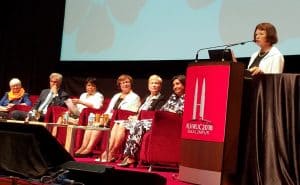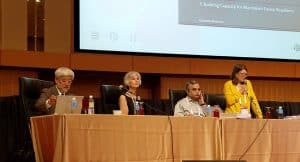
The debate rages over whether libraries can be (or even should strive to be) safe spaces, and presenters gave their takes on this topic in “Sanctuaries in the City: The Public Library As a Safe Space,” presented August 26 at the International Federation of Library Associations and Institutions’ (IFLA) World Library and Information Congress in Kuala Lumpur, Malaysia. The session was sponsored by the Metropolitan Libraries Section.
Leonee Ariel Derr, team leader at Stonnington Library and Information Service in Melbourne, Australia, came down squarely against the safe-space idea, explaining through examples drawn from her many years working in several Melbourne-area public libraries that safety for patrons and staff—whether physical or emotional—cannot be guaranteed. The risks of working in an all-welcoming public space include violence, drug use and overdose, sexual activity, stalking, and unexpected bodily fluids. Library policies (such as whether or not to let patrons sleep), collections, and events cannot be neutral. But she welcomes the unpredictable work of “social justice in action” that comes with having a space open to the public and believes librarians must buck the trend of claiming to be neutral.
Benjamin Walsh, user services librarian at the University of Toronto’s Robarts Library, spoke about LGBT homeless youth and how they locate private spaces for information gathering, entertainment, and shelter. In his research, Walsh found that this “hidden homeless” population tends to use what he calls “urban hybrid space,” such as coffee shops, Apple stores, and academic libraries. LGBT youth are drawn to urban academic libraries more than public libraries because their age, drug use, and hygiene issues stand out less than they would in public libraries. He noted that it can be hard to create or define services for a population that you can’t see, but libraries that want to serve these patrons can partner with shelters for homeless youth. Walsh said 20%–40% of homeless youth identify as LGBT.
Madison (Wis.) Public Library’s Central branch renovation in 2013 was fueled by calls for making the library a safer space. Traci Engel Lesneski, principal at MSR Design, showed how her firm took a building that locals had wanted to demolish and instead rehabbed it to make it safer both indoors and out, with more lighting and seating so the community’s homeless population would not cluster in one area. MSR and the library staff also worked with social service agencies, law enforcement, and residents to get feedback on what the community needed from the library and how it could serve all of its patrons. The Central branch now features onsite social work services and 50 hours of case management per week, a dedicated entrance for the children’s section, and space for hosting weddings.
The Ideas Box, pop-up portable libraries contained in durable, easy-to-set-up units, is a project of Libraries without Borders. Muy Cheng Peich, director of education, contents, and training for the organization, described how the units offer books, laptops, and internet connectivity in disaster zones and refugee camps and are now used in safe-haven areas in Europe to aid migrants. The Ideas Box facilities provide safe spaces for community activities as well as information access. Peich and her colleagues found that these activities helped acclimate immigrants to their new surroundings.
Social networks and libraries
In the August 26 afternoon session, “Looking for the Next Big Thing: Libraries and Social Networks,” the “next big thing” for each library depended on its needs for marketing, engagement, or collaboration. Most of the presenters were still relying on established platforms rather than experimenting with new technology.
Library and Archives Canada (LAC), for example, has enjoyed some viral success on social media for its April Fool’s Day Facebook reveal of Marvel Comics superhero Wolverine’s military records (which also promoted LAC’s largest-ever digital project, a mass digitization of World War I–era personal files) to a May 4 (Star Wars Day) tweet about its new preservation facility housing all Death Star plans, complete with a doctored photo of Librarian and Archivist of Canada Guy Berthiaume standing nervously next to a fully-costumed Darth Vader.
Berthiaume said LAC’s social media presence is intentionally irreverent and amusing in order to “demystify library science.” So far, negative feedback has been minimal and manageable. He believes this tactic is more engaging than a faceless government bureaucratic approach, and his staffers know he will support them in the event that they encounter a social media backlash for their posts.
Mimi Calter, deputy university librarian at Stanford (Calif.) University, demonstrated how Stanford’s communications team uses blogging to provide compelling content for all of its social media channels rather than creating content for each platform from scratch. Blog posts and photos are repurposed for other channels, including the university’s media, and they are sometimes picked up by external sources as well.
Knowing the right platform to use depends on your audience. Raisa Fadelina, a student at Sunan Kalijaga State Islamic University Yogyakarta, described her case study showing that a large percentage of the students who used the Grhatama public library in Yogyakarta, Indonesia, also used Instagram. The library started posting images on Instagram with information about programs, library hours, and services to the platform for its users.
Charles Brilee of the National Library of Malaysia (NLM) studied five years’ worth of NLM’s posting and engagement data to find which platforms the library’s users were most involved with and where NLM should devote its limited time and resources.
Shamim Akhtar Munshi surveyed students and faculty at two universities in India—Aligarh Muslim University in Uttar Pradesh state and Jawaharlal Nehru University in New Delhi—about their social media use and found that the libraries’ use of social media platforms led to increases in the use of the physical libraries as well as their online services.
To promote its First Five Forever early literacy program, the State Library of Queensland, Australia, turned to video as an effective way to communicate quickly and on a budget. According to State Librarian and CEO Vicki McDonald, the library produced four videos over four years, ranging in cost from AU$400 to AU$10,000. Each has a different theme, but all convey that the program is free, fun, good for your child, and local. The combined videos have racked up more than 500,000 views.


